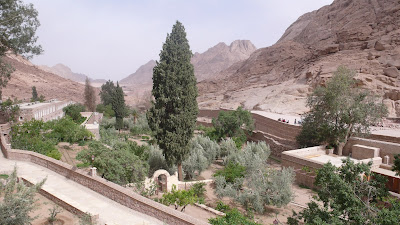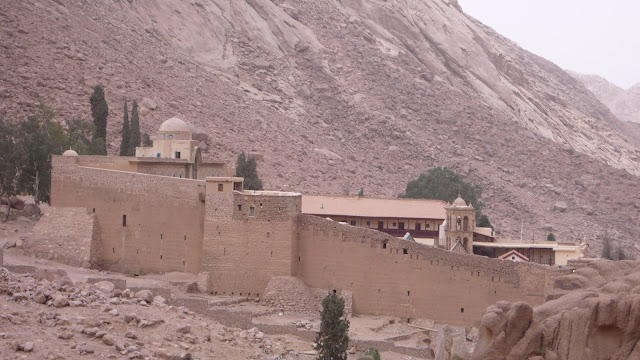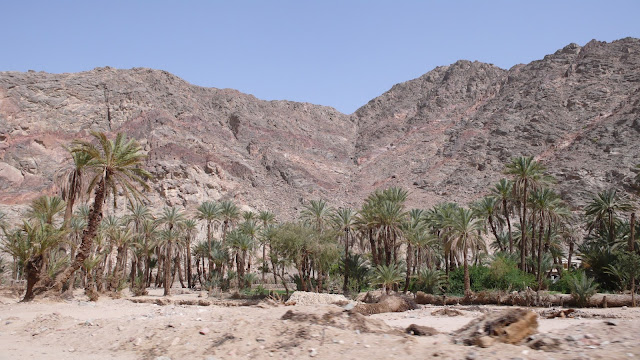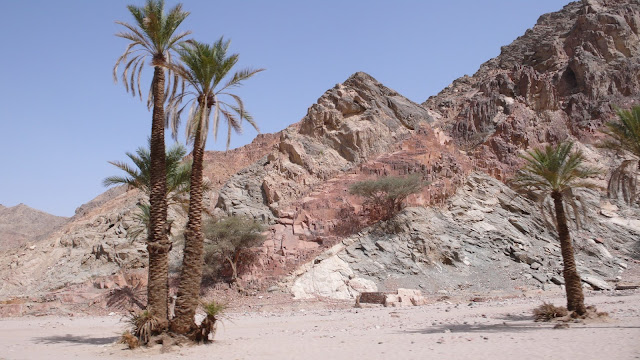St. Catherine's Monastery is an Orthodox monastery on the Sinai peninsula at the foot of Mount Sinai in Egypt. One of the oldest Christian monasteries in the world, St. Catherine's incorporates the burning bush seen by Moses and contains many valuable icons. Above the monastery is Mount Sinai (see separate article), where Moses received the Ten Commandments from God. Because God spoke to Moses in these places, this area is sacred to three world religions: Christianity, Islam and Judaism.
What to See at St. Catherine's Monastery
St. Catherine's Monastery comprises the
entire Orthodox Church of Mount Sinai, an autonomous Orthodox Christian church
headed by an archbishop, who is also the abbot of the monastery. The archbishop
is traditionally consecrated by the Orthodox Patriarch of Jerusalem. St. Catherine's Monastery is surrounded on
all sides by a massive wall 2.5 m wide and 11m high. This is the wall provided
by Emperor Justinian in the 6th century. It is made of huge dressed granite
blocks except for the upper sections, which were restored on orders of Napoleon
using smaller, undressed stone blocks. Christian symbols, such as crosses and
monograms, are carved on the wall in various places. Until the 20th century,
access was through a door high in the outer walls. The entrance is now through
a smaller gate (also original) to the left of the main gate. The holiest part of the monastery is the
large living shrub that is said to be a direct descendent of the very burning
bush that was seen by Moses. The Chapel of the Burning Bush was built with its
altar situated above the roots of the bush and incorporates the 4th-century
chapel built by Empress St. Helena. The chapel is dedicated to the Virgin Mary.
The bust itself was transplanted to permit the construction of the altar and
now grows a few meters from the chapel. It is a rare species of the rose family
called Rubus Sanctus. The bush is native to Sinai and extremely long-lived,
facts that help lend credibility to the site.
The main church of the monastery is the Basilica of the Transfiguration (or Katholikon), which was built of granite by the Byzantine architect Stephanos at the same time as the defensive walls. The church structure, the roof, and the carved cedar doors at the entrance are all originals from 527 AD. Inside, the basilica has a broad main nave, two side aisles, an apse and a narthex. The nave is bordered by massive granite columns with capitals decorated with Christian symbols. Each aisle has three chapels and there is a chapel on each side of the apse. Next to the main altar is a sarcophagus with the relics of St. Catherine (head and hand). The ceiling, marble floor and elaborate iconostasis of the basilica date from the 18th century. The icons, mosaics and works of art that decorate the interior span many centuries. The doors of the narthex were added by Crusaders in the 11th century.
The neo-Classical bell tower was built in 1871 by one of the monks, Gregorius. It houses nine bells given by the Tsar of Russia. A continual supply of fresh water is provided to the monastery by the Well of Moses, which taps an underground spring. According to tradition, this stands on the very spot where Moses met his future wife, Zipporah, after protecting her and her sisters from an aggressive group of local shepherds (Exodus 2:16-21). The monks' cells are constructed along the inner faces of the defensive walls. The rectangular Old Refectory (also known as the "Crusader's Church") has a Gothic vaulted roof whose arches are decorated with the arms and other symbols of Crusader knights. Murals on the walls date from the Crusader period and the 16th century. The central feature is a long table with fine carvings, brought from Corfu in the 18th century. The library at St. Catherine's is the oldest in the Christian world and preserves the second largest collection of early codices and manuscripts in the world (outnumbered only by the Vatican Library). Its collection includes more than 3000 manuscripts and more than 5000 early religious books. The library also has a precious collection of more than 2000 icons of Christ, Mary and the saints, displayed in a special gallery. These represent almost every school of Byzantine iconography from the 6th to the 18th century.
{ Text from http://www.sacred-destinations.com }
Photos : Harpas Stathis
































Δεν υπάρχουν σχόλια:
Δημοσίευση σχολίου